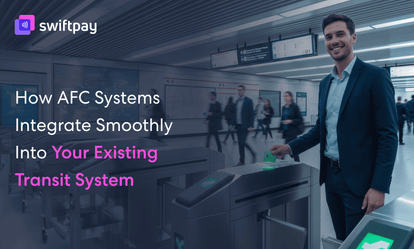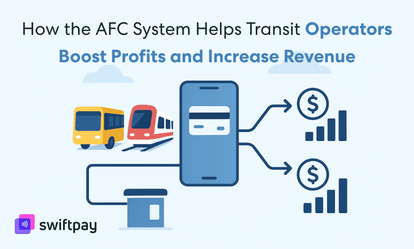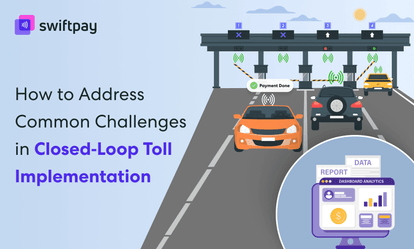Drivers don't complain about parking when it's easy. They complain when it's a hassle.
Finding a parking spot is already a big headache in urban areas. So making the payment for parking should be among the least concerns for the users.
But the reality is that many parking facilities have outdated and inefficient payment systems. This means clunky interfaces, confusing instructions, and unexpected fees. All of these lead to user frustration and create a ripple effect that parking operators like you feel in their bottom line.
What you need to understand is that convenience isn’t a vague concept. Users know exactly what they want: speed, clarity, and control.
Besides, convenience shouldn’t just apply to the driver—it should extend to your back office too. If your parking payment system is creating more work for your team than it’s solving, it’s not truly convenient.
If your system isn’t delivering that, it’s holding your business back.
This blog breaks down what modern users really expect from your payment experience and how meeting those expectations can improve customer loyalty and increase operational revenue.
Let’s start by understanding why convenience matters in parking.
Why convenience matters more than ever in parking
The concept of convenience has evolved dramatically. Users bring expectations formed by seamless experiences in other areas of their lives—from one-click shopping to instant ride-hailing services. And why shouldn’t they?
Parking operators like you must understand that users aren’t just looking for a way to pay. They’re looking for a way out. A smooth entry, quick parking, and stress-free payment process. If any part of that journey breaks down, satisfaction plummets.
Convenience is not limited to payment—it’s about the entire experience
People are leading lives that are digitally dominant, and smartphones are at the centre of it. Hence, people expect the same level of convenience from parking as they do from ordering a coffee or booking a ride.
"Frictionless" has moved from being a luxury differentiator to a baseline expectation when it comes to payments. So, when users encounter parking payment systems that feel outdated or cumbersome, they don't merely feel inconvenienced—they feel dissatisfied as well.
Even minor snags—like a failed payment or slow-loading app—can lead to poor reviews, lost return visits, and lower Net Promoter Scores.
The link between convenience, loyalty, and revenue
The business impact of payment convenience extends far beyond the immediate transaction.
Faster and smoother payments automatically lead to shorter queues, better space turnover, and ultimately higher revenue. Besides, it also helps operators like you handle peak volumes more efficiently.
When parking feels effortless, it becomes part of the positive overall destination experience, and users are likely to come back. That’s especially important in high-volume environments like malls, stadiums, and airports—where repeat visits drive serious revenue.
What is "convenience" in the context of parking payments?
In simple words, convenience in parking payment solutions comprises the following factors:
- Ease of use: A Payment platform or instrument that requires minimal thought or learning
- Speed of transactions: Quick processing from initiation to confirmation
- Accessibility across devices/platforms: Consistent experience whether using mobile, web, or physical kiosks
Why parking operators must focus on payment convenience
Michelle Weaver, Morgan Stanley’s U.S. Thematic Strategist, states:
“Consumers are willing to pay up to 5% more, on average, for convenience and they will in many cases choose one product or service over another if it is more convenient.”
Besides, there are more reasons why focusing on payment convenience for your parking facility should be among your top priorities.
- Reduced friction for customers: This means transforming a potential pain point into a seamless part of their journey, which helps in encouraging repeat visits.
- Enhanced overall customer satisfaction and loyalty: This helps in creating positive word-of-mouth and strengthening your venue's reputation.
- Optimized operational efficiency: This means you will have reduced staff intervention, faster turnover, and lower maintenance costs.
What do users really want from a parking payment system?
So, what do end-users expect when they pull into a parking lot?
Based on real-world feedback and usage patterns, here’s what matters most:
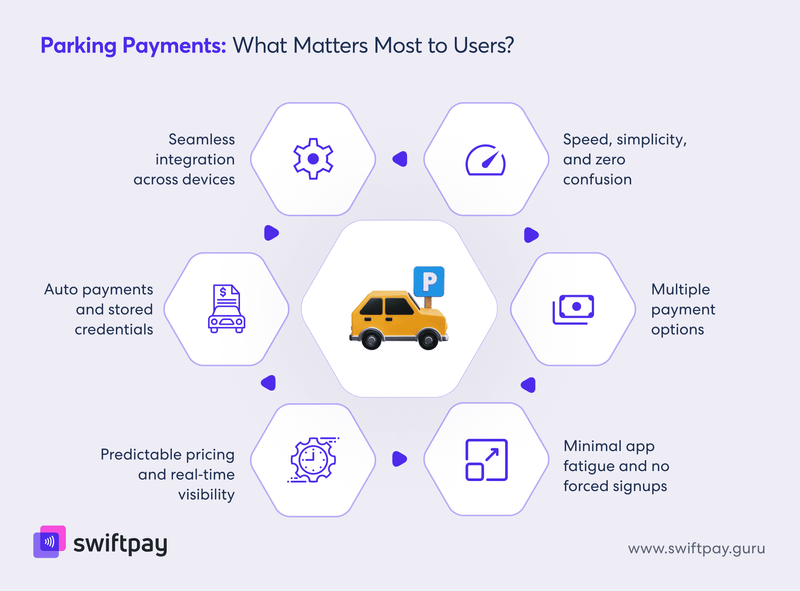
Speed, simplicity, and zero confusion
Above all, users crave payment processes that don't make them think. They don't want to go through poorly worded instructions or navigate confusing menu structures. And they certainly don't want to fumble for coins or peek at sun-faded display screens.
Whether it’s an app, web interface, or on-site kiosk, users want:
- Clear instructions
- A simple UI
- Fast confirmation
In other words: no learning curve, no guesswork, and definitely no error messages.
Multiple payment options (Without the Hassle)
Modern consumers expect flexibility in how they pay for literally anything. So why can’t they expect the same when paying for parking, right?
They want to use credit cards, mobile wallets, QR payments, in-app options, and increasingly, loyalty point redemption. Plus, the rise of contactless payments has only accelerated these expectations.
A majority of people see contactless payments as convenient and quicker than other payment options.
Yet offering multiple payment methods isn't enough if they aren't seamlessly integrated. Each additional payment option should reduce friction, not add complexity.
Minimal app fatigue and no forced signups
The "download our app" barrier has grown into a significant pain point. Not every parking session should require a new app download.
Simon Williams, a spokesperson for RAC, agrees.
“Paying for parking should be one of the simplest things any driver has to do, yet the reality has been anything but with people forced to download and register a plethora of different mobile apps depending on where they are in the country.”
Users appreciate the option of guest checkout or browser-based payments that don’t lock them into long sign-up forms. Convenience, in this case, is respecting the user’s digital space.
The best parking payment systems make app downloads optional enhancements rather than required gateways. They save the comprehensive features for frequent users and provide streamlined alternatives for occasional visitors.
Predictable pricing and real-time visibility
Users want clear information about:
- How much they'll pay based on their parking duration
- How much time do they have remaining
- Whether they need to take action to avoid penalties
If a user is left wondering, then your parking payment solution has already failed.
Real-time updates about pricing and duration build trust and eliminate anxiety. When users can easily check their status or extend their parking session from anywhere, their entire experience improves.
Auto payments and stored credentials
The gold standard for convenience is eliminating active payment entirely. It’s already effectively used in transportation and toll collection.
Users increasingly expect "set it and forget it" options such as:
- Automatic payment upon exit based on license plate recognition
- Saved payment methods that don't require re-entry
- Intelligent systems that calculate duration and process payment without user intervention
These invisible payment experiences represent the pinnacle of convenience. It’s because the transaction happens so smoothly that users barely notice it occurred.
Seamless integration across devices
The device-hopping behavior of modern consumers demands cross-platform compatibility. A truly convenient system works flawlessly whether accessed via:
- Mobile apps (iOS and Android)
- Mobile web browsers
- Desktop browsers
- Physical kiosks or terminals
Additionally, smart offline capabilities for areas with poor connectivity prevent frustrating payment failures in underground garages or remote locations.
Read more - Benefits of Having a Closed-Loop Parking Payment System
Where most parking payment systems fall short
Despite advancements in payment technology, many parking systems continue to disappoint users. Here are some common pitfalls:
- Inconsistent experiences across locations or cities
- Outdated machines that don’t support mobile
- Hidden fees, confusing UIs, and unclear instructions
- Long sign-up processes or broken guest checkout flows
- Unreliable QR codes or NFC scanners
What does convenience mean for parking operators
While user convenience drives adoption and satisfaction, it also delivers substantial operational benefits for parking facility operators. Here’s how:
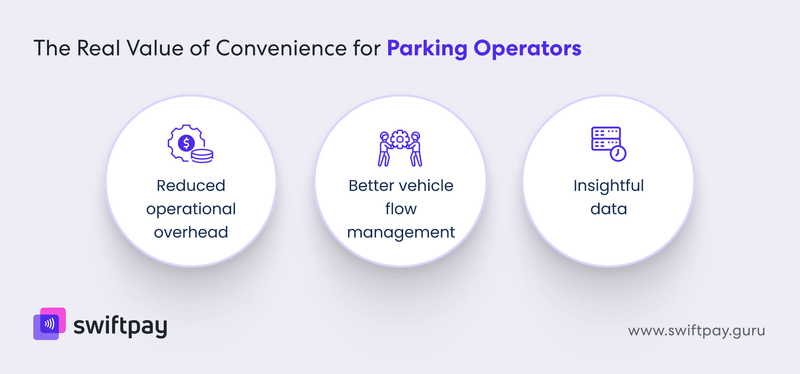
Reduced operational overhead
Cashless parking payment systems dramatically reduce the operational burdens associated with traditional parking payments. Because:
- Less cash handling means fewer security concerns, reduced counting errors, and lower banking fees
- Digital systems require less frequent physical maintenance than mechanical components
- Staff can focus on higher-value activities rather than troubleshooting payment issues or making changes
Better vehicle flow management
Smart parking payments directly impact your facility’s effectiveness, which is a critical metric for profitability. Hence, faster entry and exit processing means:
- Reduced queuing during peak periods
- More efficient use of available capacity
- Higher total vehicle throughput without expanding physical infrastructure
These benefits prove especially valuable during high-demand periods like event parking, holiday shopping, or airport peak times when maximizing flow directly impacts customer satisfaction and revenue.
More data, smarter decisions
Automated parking payment systems generate rich operational intelligence that simply doesn't exist with traditional systems. Here are the types of insights you can expect:
- Usage patterns: When are your peak hours? How long do different customer segments typically stay?
- Payment preferences: Which payment methods do your customers prefer? How does this vary by time of day or day of week?
- Price sensitivity: How do different pricing structures impact occupancy and dwell time?
These kind of insights lets you make decisions about staffing, pricing optimization, marketing promotions, and facility improvements based on actual data.
This helps you create a continuous improvement cycle that enhances both profitability and user experience.
How SwiftPay can take parking payment convenience to the next level
Most digital parking systems make the process faster. But convenience is not just about quickness. It also involves improving the overall payment experience.
SwiftPay can handle that effortlessly. As a closed-loop payment solution, it gives operators like you full control over transactions while also creating a smoother and smarter payment experience for your users. No third parties, no added friction—just one streamlined platform built for convenience.
Here’s how SwiftPay takes parking payments to the next level:
-
Built-in loyalty, rewards, and membership perks: SwiftPay integrates seamlessly with loyalty programs. This means automatically applying discounts, tracking reward points, and managing VIP access or corporate privileges—no cards or codes needed.
-
Frictionless repeat visits: Returning users are recognized instantly across locations through license plate data and stored profiles. This enables faster check-ins, automatic payments, and consistent experiences everywhere they go.
-
Financial control for operators: By bypassing traditional card networks and processors, SwiftPay reduces transaction fees, eliminates third-party commissions, and enables more flexible pricing—all while keeping revenue in-house.
Final words
Convenience builds loyalty. And loyalty drives revenue.
When your users feel in control of their parking experience—with clear information, flexible options, and minimal effort requirements—they develop positive associations with your facility. These positive impressions translate directly into preference, loyalty, and willingness to pay premium rates for superior experiences.
Parking operators like you need to ask yourself: Is your system built for you—or for the people who use it every day?
The message is clear: you can’t rely on traditional systems because customers have moved on.
Your parking facility needs a smart and automated payment system. And if you are thinking of that, then a closed-loop payment system can be ideal for parking. These systems solve all the payment pain points that users face with traditional parking payment systems.
Apart from that, it helps you achieve optimum operational efficiency along with enhanced customer preference and loyalty.
SwiftPay will understand your exact business requirements and deliver a tailored closed-loop payment system for your parking lot.
Remember: investing in modern, user-centric payment systems isn’t just good service—it’s good business too. That's how you stand out from your competitors.


